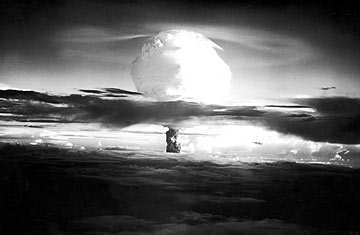
Is Italy capable of delivering a thermonuclear strike? Could the Belgians and the Dutch drop hydrogen bombs on enemy targets? And what about Germany — a country where fear of atomkraft is so great that the last government opposed all civilian nuclear power? Germany's air force couldn't possibly be training to deliver bombs 13 times more powerful than the one that destroyed Hiroshima, could it?
It is Europe's dirty secret that the list of nuclear-capable countries extends beyond those that have built their own weapons — Britain, France and Russia. The truth is that Belgium, Germany, Italy and the Netherlands store nuclear bombs on their air-force bases and have planes capable of delivering them. There are an estimated 200 B-61 thermonuclear-gravity bombs scattered across these four countries. Under a NATO agreement struck during the Cold War, the bombs, which are owned by the U.S., can be transferred to the control of a host nation's air force in time of conflict. Twenty years after the fall of the Berlin Wall, Dutch, Belgian, Italian and German pilots remain ready to engage in nuclear war.
These weapons are more than a historical oddity. They are a violation of the spirit of the Nuclear Non-Proliferation Treaty (NPT) — the 1968 agreement governing nuclear weapons that provides a legal restraint to the nuclear ambitions of rogue states. Because "nuclear burden-sharing," as the dispersion of B-61s in Europe is called, was set up before the NPT came into force, it is technically legal. But as signatories to the NPT, the four European countries and the U.S. have pledged "not to receive the transfer ... of nuclear weapons or control over such weapons directly, or indirectly." That, of course, is precisely what the long-standing NATO arrangement entails.
While burden-sharing was tolerated during the Cold War, it has become an irritant at NPT review conferences, where some countries have used it as an example of the U.S.'s failure to take serious steps toward nuclear disarmament — part of its obligation under the treaty. Last year a U.S. Air Force report found that the European bases storing the weapons were failing to meet security requirements to safeguard the weapons. These revelations cemented the unpopularity of the agreement. Belgium's Parliament had already unanimously requested that NATO withdraw the weapons, while a 2006 poll found that almost 70% of people in the four countries want the U.S. nukes withdrawn. In October, German Foreign Minister Guido Westerwelle declared that Barack Obama's speech in Prague in April, in which the U.S. President called for countries to renew the vision of a world free of nuclear weapons, had "opened the door" to a nuke-free Europe.
But elements in the NATO military structure are protective of the weapons. In 2008 a speaker for the Secretary of Defense Task Force on Nuclear Weapons Management said the bombs were an important guarantee of NATO security and also supported nonproliferation efforts by preventing allied states from developing their own weapons programs. The report concluded that the presence of B-61s in Europe "remains an essential political and military link between European and North American members of the alliance."
These justifications infuriate arms-control experts, who point out that NATO countries continue to be protected by hundreds of land- and submarine-based long-range nuclear-tipped missiles. "The nuclear umbrella can be continued by long-range forces just like it was in the Pacific after [nuclear] weapons were withdrawn from South Korea in 1991," says Hans Kristensen of the Federation of American Scientists. As for the concern that allied countries might be driven to develop their own weapons, Kristensen is scathing: "How many [European] countries would seriously consider acquiring their own weapons if things changed? Denmark? Iceland? Portugal? Seriously!"
Recent U.S.-Russia bilateral negotiations to reduce long-range weapons did not cover B-61s in Europe. Obama's ongoing "nuclear posture review" and NATO's review of its strategic concept may call for an end to nuclear burden-sharing. But if the issue is not addressed soon, countries may take their own steps to get rid of the weapons. In 2001, when the Greek air force ordered a new fighter jet, it chose a model that could not carry the B-61, forcing the U.S. to withdraw its weapons there. The U.S. still keeps weapons in Turkey, but some experts say the Turkish air force is no longer involved. Germany may soon retire its Tornado fighter jet, opting instead for the Eurofighter, which can't carry B-61s. "NATO countries are currently answering the question backward. We are allowing aircraft selection to determine our posture," says Heather Conley of the Center for Strategic and International Studies. Given that Europe's hidden nuclear arsenal is unpopular, potentially unsafe and a hindrance to global nonproliferation efforts, it's time for it to go.
